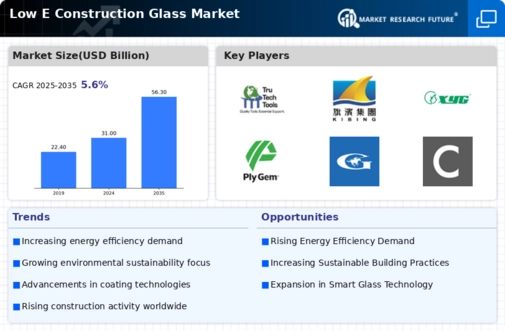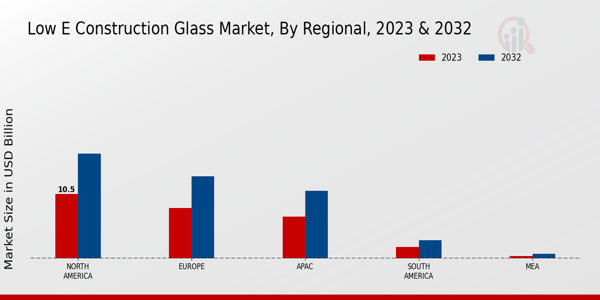Market Growth Projections
The Global Low E Construction Glass Market Industry is projected to experience substantial growth over the next decade. With a market value of 31.0 USD Billion in 2024, it is expected to reach 56.3 USD Billion by 2035, indicating a robust trajectory. The compound annual growth rate of 5.57% from 2025 to 2035 reflects the increasing adoption of Low E glass in various construction applications. This growth is driven by factors such as rising energy costs, technological advancements, and heightened awareness of sustainability. The market's expansion underscores the critical role of Low E glass in achieving energy efficiency in the construction sector.
Growth in the Construction Sector
The expansion of the construction sector globally is a significant driver for the Global Low E Construction Glass Market Industry. As urbanization continues to accelerate, there is an increasing demand for residential and commercial buildings that incorporate energy-efficient solutions. This growth is particularly evident in emerging economies, where rapid urban development is taking place. Consequently, the demand for Low E glass is expected to rise, as builders seek to comply with energy efficiency standards. This trend is anticipated to contribute to the market's overall growth trajectory, reinforcing the importance of Low E glass in modern construction.
Rising Demand for Energy Efficiency
The Global Low E Construction Glass Market Industry experiences a notable surge in demand driven by the increasing emphasis on energy efficiency in building designs. Governments worldwide are implementing stringent regulations aimed at reducing energy consumption in residential and commercial buildings. For instance, the adoption of Low E glass can significantly lower heating and cooling costs, appealing to environmentally conscious consumers. As a result, the market is projected to reach 31.0 USD Billion in 2024, reflecting a growing preference for sustainable building materials. This trend indicates a shift towards energy-efficient solutions, which is likely to bolster the market further.
Government Incentives and Regulations
Government incentives and regulations play a crucial role in shaping the Global Low E Construction Glass Market Industry. Many countries are introducing financial incentives for the use of energy-efficient materials in construction, including Low E glass. These initiatives often aim to meet national energy efficiency targets and reduce greenhouse gas emissions. For example, tax credits and rebates for energy-efficient renovations encourage homeowners and builders to opt for Low E glass. Such policies are likely to stimulate market growth, as they create a favorable environment for the adoption of energy-efficient building materials.
Technological Advancements in Glass Manufacturing
Technological innovations in glass manufacturing processes are propelling the Global Low E Construction Glass Market Industry forward. Advances such as magnetron sputtering and vacuum deposition techniques enhance the performance of Low E glass, improving its thermal insulation properties. These technologies enable manufacturers to produce glass that meets the evolving demands of architects and builders. As a result, the market is expected to witness a compound annual growth rate of 5.57% from 2025 to 2035. This growth is indicative of the industry's commitment to integrating cutting-edge technology to meet energy efficiency standards and consumer preferences.
Increased Awareness of Sustainable Building Practices
There is a growing awareness of sustainable building practices among architects, builders, and consumers, which is positively influencing the Global Low E Construction Glass Market Industry. This awareness is often driven by educational initiatives and the promotion of green building certifications, such as LEED. As stakeholders recognize the benefits of Low E glass in reducing carbon footprints and enhancing indoor comfort, demand is likely to increase. This trend aligns with the projected market growth, with estimates suggesting a rise to 56.3 USD Billion by 2035, highlighting the industry's potential to contribute to sustainable development.














